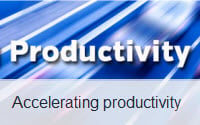
In several of our recent engagements we have witnessed first-hand the enormous amount of pressure on CEOs to meet the stringent demands of both stakeholders and customers. One such demand that continues to be a top priority for executives is employee productivity. Our experience tells us that a decline in workforce performance and efficiency can put a major dent in an organization’s bottom line.
Fear not! Over the course of almost 70 years, we have applied a proven methodlogy that consists of 10 ways to spark productivity for our clients. They include:
- Indentifying productivity as a strategic initiative -- It must begin with the CEO and then trickle its way down the organization.
- Aim High -- Improvement goals should be ambitious; pushing the boundaries of excellence.
- Question, measure, change -- A productivity improvement plan must question how every facet of the business is performing (people, processes, equipment, etc). It must include resources that measure success before significant changes are made.
- Improve management planning/supervision -- Based on our findings, inadequate management planning and supervision are significant causes for lost productivity. It is imperative for management to have skills that enable them to lead effectively.
- Classroom and on-the-job training -- Skills development can galvanize an unproductive workforce. Three hours of one-on-one coaching should be given for every hour spent in the classroom.
- Visible change -- The old saying "seeing is believing" certaily holds true here. Even the smallest change, such as cleaning a shop floor on a weekly basis, can have a positive influence on people.
- The need for speed -- Small-scale initiatives working independently of each other will not work. Running a process improvement plan concurrently across all aspects of the business will generate rapid results.
- Breaking it down -- Monitoring hourly performance instead of daily or weekly can prevent minor issues from escalting.
- Clear communication -- CEOs must be honest and forthcoming as to why things need to change. People must understand their roles and responsibilities from day one.
- Continuity -- Productivity improvement is a constantly moving target. Leaders must plan accordingly as best practices and technology continue to evolve.
You may also like...
 |
 |
 |
